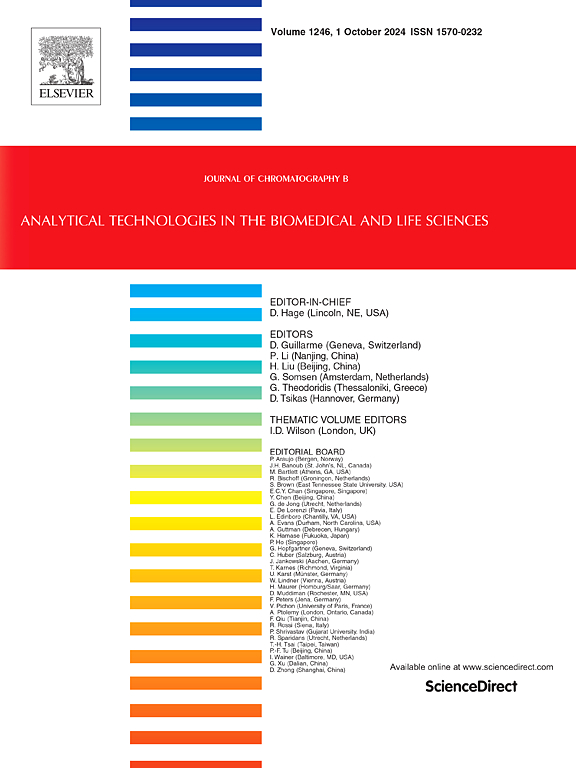QuEChERS萃取- uplc -MS/MS同时测定海带和紫菜中氯霉素类药物含量的方法建立及验证
IF 2.8
3区 医学
Q2 BIOCHEMICAL RESEARCH METHODS
引用次数: 0
摘要
海带和紫菜样品中氯霉素的含量分析对海带产品的质量控制具有重要意义。本研究建立了QuEChERS联合超高效液相色谱-串联质谱(UPLC-MS/MS)分离检测海带和紫菜中氯霉素、硫霉素和氟苯尼考残留量的方法。提取溶剂为乙腈,以石墨化炭黑(GCB)与C18的1:1混合为净化剂。采用负离子模式电喷雾电离(ESI) +多反应监测(MRM),结合同位素内标定量方法。结果表明,氯霉素、硫霉素和氟苯尼考在0.0005 ~ 0.050 μg/mL范围内呈良好的线性关系,相关系数(r)为0.999。方法检出限为0.4 μg/kg,定量限为1.0 μg/kg。在1.0 μg/kg ~ 10.0 μg/kg浓度范围内,氯霉素的回收率为87.4% ~ 103.4%,相对标准偏差(rsd)为2.1% ~ 5%。用该方法对20批样品进行了检测,其中1批海带中氯霉素含量约为2.0 μg/kg。该方法采用简单、经济的样品前处理技术,适用于定性测定。在对大量含CAPs的海藻产品进行监测时,满足实验要求的准确性和灵敏度。本文章由计算机程序翻译,如有差异,请以英文原文为准。

Development and validation of a QuEChERS extraction-UPLC-MS/MS method for the simultaneous determination of chloramphenicol drugs in Laminaria japonica and Porphyra yezoensis
The analysis of the content of chloramphenicol (CAPs) in Laminaria japonica and Porphyra yezoensis samples is crucial for quality control of seaweed products. In this study, the analytical method using QuEChERS combined with Ultra-High-Performance Liquid Chromatography-Tandem Mass Spectrometry (UPLC-MS/MS) was established to separate and detect residues of chloramphenicol, thiamphenicol, and florfenicol in Laminaria japonica and Porphyra yezoensis. The extraction solvent used was acetonitrile, and a 1:1 mixture of graphitized carbon black (GCB) and C18 was employed as the purifying agent. Electrospray ionization (ESI) in negative ion mode with multiple reaction monitoring (MRM) was employed, coupled with the isotope internal standard quantification method. The results demonstrated good linearity within a range of 0.0005–0.050 μg/mL for chloramphenicol, thiamphenicol, and florfenicol with correlation coefficient (r) of 0.999. The method detection limit was 0.4 μg/kg, while the quantitation limit was 1.0 μg/kg. Furthermore, during validation experiments where concentrations ranging from 1.0 μg/kg to 10.0 μg/kg were added to samples, recovery rates for chloramphenicol ranged from 87.4 % to 103.4 %, with relative standard deviations (RSDs) between 2.1 % and 5 %. This developed method was applied to test twenty batches of samples in which one batch of Laminaria japonica was found to contain a chloramphenicol concentration of approximately 2.0 μg/kg. The developed method, which uses simple and cost-effective sample pretreatment techniques, is suitable for qualitative determination. It satisfies the experimental requirements in terms of accuracy and sensitivity when monitoring large quantities of marine algae products containing CAPs.
求助全文
通过发布文献求助,成功后即可免费获取论文全文。
去求助
来源期刊

Journal of Chromatography B
医学-分析化学
CiteScore
5.60
自引率
3.30%
发文量
306
审稿时长
44 days
期刊介绍:
The Journal of Chromatography B publishes papers on developments in separation science relevant to biology and biomedical research including both fundamental advances and applications. Analytical techniques which may be considered include the various facets of chromatography, electrophoresis and related methods, affinity and immunoaffinity-based methodologies, hyphenated and other multi-dimensional techniques, and microanalytical approaches. The journal also considers articles reporting developments in sample preparation, detection techniques including mass spectrometry, and data handling and analysis.
Developments related to preparative separations for the isolation and purification of components of biological systems may be published, including chromatographic and electrophoretic methods, affinity separations, field flow fractionation and other preparative approaches.
Applications to the analysis of biological systems and samples will be considered when the analytical science contains a significant element of novelty, e.g. a new approach to the separation of a compound, novel combination of analytical techniques, or significantly improved analytical performance.
 求助内容:
求助内容: 应助结果提醒方式:
应助结果提醒方式:


